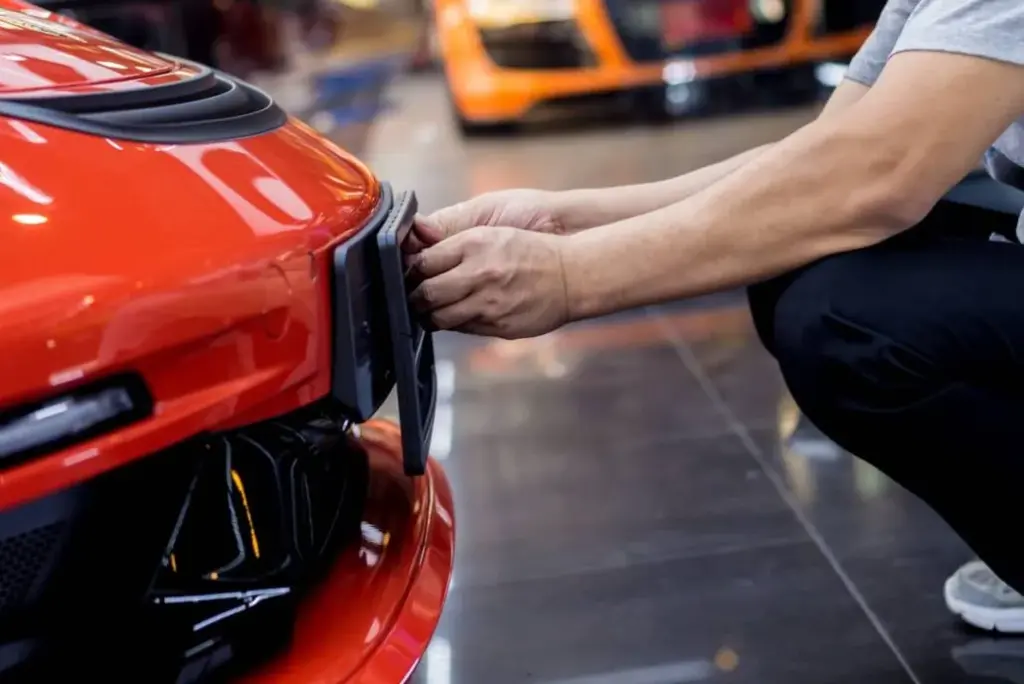Legal Clarity: Navigating DVLA Regulations with Replacement Plates
We all know that number plates are used to identify vehicles on UK roads but they also play a crucial role in ensuring vehicle legality and safety on the UK roads. Understanding and adhering to DVLA regulations regarding these plates is important, otherwise you could find yourself on the wrong side of the law. Non-compliant plates can result in fines, penalty points on driving licences, and in extreme cases, vehicle seizure. Therefore, having clear and accessible information about these regulations is essential for vehicle owners.
DVLA regulations concerning replacement plates aren’t just rules because they’re a safeguard for keeping your vehicle lawful and safe on the roads. Straying from these regulations isn’t just inconvenient as it poses risks no driver wants to encounter. Therefore, familiarising yourself with and adhering to these rules isn’t Just about obeying the law as it’s about ensuring a trouble-free and secure driving experience.
Understanding the Law
When it comes to replacement plates, two key regulations, namely The Road Vehicles (Construction and Use) Regulations 1986 and The Registration Plates (Display on Vehicles) Regulations 2001, serve as the bedrock of guidelines. These regulations lay out stringent specifications governing the dimensions, lettering, spacing, and style of replacement plates. Comprehending these rules is fundamental for vehicle owners as they delve into the intricacies of standard, cherished, and short plates, ensuring adherence to legal requirements and debunking any misconceptions.
The Road Vehicles (Construction and Use) Regulations 1986 meticulously details the specifications concerning the display of number plates on vehicles. It outlines specific requirements for the characters’ height, width, and spacing, ensuring clarity and visibility. According to these regulations, the characters must be of a certain height and width with specific spacing between them. Any deviation from these prescribed dimensions could render the plate non-compliant.
On the other hand, The Registration Plates (Display on Vehicles) Regulations 2001 delineate further criteria regarding the layout and design of number plates. This regulation also extends to personalised or cherished plates, outlining rules for these customised variants.
There’s a notable difference between standard, cherished, and short plates. Standard plates, as the name suggests, follow the general specifications outlined by these regulations. Cherished plates, often personalised or customised, require explicit authorisation and compliance with additional rules. Short plates, permitted under specific circumstances, must still adhere to dimensional and character-spacing regulations.
Common misconceptions surrounding replacement plates often revolve around font styles, decorative features, or alterations. It’s essential to dispel any confusion about the permissibility of modifications that deviate from the stipulated guidelines, as such alterations could lead to non-compliance.
Understanding these regulations is pivotal for vehicle owners seeking replacement plates. Clarity on legal requirements not only ensures compliance but also guarantees road legality and safety.
Choosing the Right Plates
The journey toward compliant replacement plates commences with a critical choice: selecting an authorised supplier that aligns with DVLA standards. This initial step ensures not only legality but also quality and adherence to regulatory measures. Exploring various plate materials and their reflective properties becomes a crucial subsequent consideration, balancing both compliance and personal preferences.
An authorised number plate supplier stands as the cornerstone of compliance. These suppliers, sanctioned by the DVLA, guarantee plates that meet the stringent legal requirements. Opting for such suppliers ensures that the replacement plates adhere to stipulated regulations concerning dimensions, font, and spacing, assuring both legality and road safety.
Understanding the different plate materials available aids vehicle owners in making informed decisions. Various materials possess distinct reflective properties, impacting visibility and compliance. Reflective materials like acrylic or aluminium offer different levels of durability and reflectivity, influencing the plates’ compliance with legal requirements. While personal preferences play a role, aligning with DVLA-approved materials is paramount.
Cherished plates, often preferred for their personalised touch, require an understanding of their unique application procedures and eligibility criteria. These plates, personalised to reflect names, phrases, or specific numbers, need explicit authorisation from the DVLA. Application processes typically involve certain costs and specific documentation requirements, ensuring that these cherished plates comply with legal standards.
Touching on the subject of personalised or decorative plates, it’s essential to tread cautiously. Non-compliant modifications or alterations to plates, including decorative elements or font styles that deviate from prescribed regulations, might lead to non-compliance. Advising against such options ensures that replacement plates adhere strictly to DVLA standards, ensuring both legality and road safety.
Choosing replacement plates requires a balance between personal preferences and legal compliance. Opting for authorised suppliers, understanding materials, and considering the specifics of cherished or personalised plates ensures not just a personal touch but also adherence to legal requirements.
Installation and Maintenance
Ensuring replacement plates are affixed securely to vehicles stands as a crucial step toward compliance with DVLA regulations. The proper installation process, according to DVLA guidelines, involves securely fixing the plates using the designated mounting points on the vehicle. It’s vital to use screws or fittings that don’t obscure the plate’s characters or registration mark, ensuring both security and visibility as mandated by the regulations.
Addressing concerns surrounding damaged or faded plates necessitates understanding the legal requirements for their replacement. In the event of damage or fading that compromises legibility or compliance, DVLA guidelines mandate prompt replacement. This replacement involves acquiring new plates from an authorised supplier that meets regulatory specifications. Owners need to ensure the replacement plates comply with the prescribed font, spacing, and material requirements to avoid legal repercussions.
Regular maintenance plays a pivotal role in upholding compliance. It’s essential to keep plates clean and unobstructed at all times. Regular checks for dirt, grime, or obstructions that might obscure the characters or registration mark are essential. Cleaning with mild soap and water, avoiding abrasive cleaners, maintains visibility and ensures adherence to DVLA regulations.
Maintaining replacement plates involves both installation and ongoing care. Installing plates securely while adhering to mounting regulations, promptly replacing damaged or faded plates, and ensuring regular maintenance by keeping them clean and unobstructed are fundamental aspects of ensuring compliance with DVLA guidelines.
Dealing With Penalties and Disputes
When faced with fines or penalties due to non-compliant replacement plates, understanding the process for contesting such issues is crucial. The initial step involves reviewing the reason for the penalty. Assess the specifics outlined in the notice, including the nature of the violation and the regulation allegedly breached. This information will guide the next course of action.
Contesting Fines or Penalties
The process typically involves initiating contact with the issuing authority within the stipulated time frame, usually detailed in the notice. Some authorities provide an avenue for challenging fines or penalties through an appeal process or by providing evidence of compliance. Responding promptly and precisely, addressing the specifics mentioned in the notice, is essential. Presenting clear evidence that the replacement plates indeed comply with DVLA regulations is paramount.
Appealing Decisions
If the challenge to fines or penalties is unsuccessful, there might be an option to appeal the decision. This often involves a formal appeals process outlined in the penalty notice. Presenting evidence of compliance, such as documentation from an authorised supplier or photographic evidence aligning with DVLA regulations, is critical during the appeal. Follow the provided instructions precisely and submit any necessary evidence within the specified time frame.
Avoiding Scams or Misleading Practises
Be cautious of scams or misleading practises related to replacement plates and fines. Some unscrupulous entities might exploit situations by offering misleading solutions or false promises to resolve non-compliance issues. Ensure to engage only with authorised suppliers or recognised authorities when seeking resolution for non-compliance. Always verify the legitimacy of any communications or offers regarding fines or penalties before taking any action.
Remaining vigilant and understanding the process for contesting fines or penalties related to non-compliant plates is essential. Responding promptly, presenting evidence of compliance during appeals, and being cautious of potential scams or misleading practises contribute to safeguarding against unjust penalties.
Specific Vehicle Considerations
Regulations for Non-Standard Vehicles
Vehicles like motorcycles, trailers, and other non-standard vehicles have specific regulations concerning replacement plates. These regulations often differ from those applicable to standard cars. Understanding these nuances is crucial. For instance, motorcycles may have smaller plate dimensions with specific font and spacing requirements. Trailers might have separate regulations for their plates, necessitating compliance with distinct DVLA standards.
Temporary Plates and Legal Usage
Temporary plates serve as a provisional solution for vehicles awaiting their permanent registration. These plates allow lawful usage under certain circumstances. However, it’s vital to understand the limitations and permitted scenarios for their use. Temporary plates are generally issued for specific durations, often linked to the registration process, and must adhere strictly to the outlined usage guidelines to remain compliant with DVLA regulations.
Considerations for International Travel
When driving abroad, it’s essential to comply with the respective country’s regulations concerning number plates. Some countries have specific requirements for international drivers, including temporary or special plates. Understanding and adhering to these requirements are crucial to avoid legal issues or complications while driving abroad. Additionally, for individuals travelling between countries frequently, researching and understanding the international standards for number plates can be beneficial, ensuring compliance during cross-border travel.
Facing the unique regulations for motorcycles, trailers, and non-standard vehicles concerning replacement plates is imperative for owners of such vehicles. Understanding the distinct requirements, limitations, and usage scenarios for temporary plates, along with adhering to international travel considerations regarding plate requirements, contributes to maintaining legal compliance across different vehicle types and travel scenarios.
Personalisation and Creativity
Choosing Legal Personalised Plates
When opting for personalised plates, it’s essential to strike a balance between creativity and adherence to legal guidelines. Selecting a personalised plate that reflects individuality while staying compliant with DVLA regulations is key. Start by brainstorming unique combinations that hold personal significance but avoid potentially offensive content or misleading combinations that might breach regulations.
Understanding Limitations and Restrictions
Personalised plates have limitations and restrictions concerning content. DVLA regulations prohibit certain combinations that may be offensive or misleading. It’s crucial to be aware of these limitations to avoid rejection or penalties. Avoid using offensive language, political or religious references, or combinations that could mislead other drivers or law enforcement.
Examples of Creative Customisations
Creativity within legal boundaries opens various avenues for personalising vehicles. Consider using initials, birthdates, or significant numbers and letters that hold personal meaning. Incorporating favourite hobbies or interests through subtle references can add a unique touch without breaching regulations. Utilising legal symbols like hearts, stars, or specific character arrangements can also personalise plates while ensuring compliance.
Understanding and exploring the range of personalised plates involves thoughtful consideration of content to express individuality while staying within the legal framework. Understanding the limitations and restrictions on personalised plate content ensures compliance and prevents potential penalties or rejections. By exploring creative yet safe ways to customise vehicles within legal boundaries, owners can personalise their plates while adhering to DVLA regulations.
Finally
Ensuring adherence to DVLA regulations regarding replacement plates isn’t just about legality because it’s a commitment to road safety. Recapitulating the core essence of this guide, it’s evident that compliance with these regulations is pivotal. This is because it undoubtedly becomes a part of being a responsible vehicle owner and driver, guaranteeing safety for all road users.
Encouraging readers to delve further into the DVLA’s resources or consult authorised suppliers stands as a proactive step towards understanding and implementing the regulations. The DVLA website and authorised suppliers offer invaluable insights and guidance, resolving queries and ensuring a seamless understanding of compliance standards.
In essence, the journey towards responsible vehicle ownership commences with compliance. Understanding and accepting these regulations not only guarantees that you are not going to have to face penalties but also contributes to a safer road environment. Let’s drive forward with a shared commitment to compliance and safety on our roads.

 100% Road Legal
100% Road Legal Express Delivery
Express Delivery

